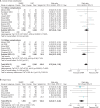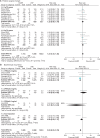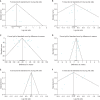Robot-assisted radical prostatectomy has lower biochemical recurrence than laparoscopic radical prostatectomy: Systematic review and meta-analysis
- PMID: 28480340
- PMCID: PMC5419109
- DOI: 10.4111/icu.2017.58.3.152
Robot-assisted radical prostatectomy has lower biochemical recurrence than laparoscopic radical prostatectomy: Systematic review and meta-analysis
Erratum in
-
CORRIGENDUM: Correction of the Figure. Robot-assisted radical prostatectomy has lower biochemical recurrence than laparoscopic radical prostatectomy: Systematic review and meta-analysis.Investig Clin Urol. 2017 Sep;58(5):383. doi: 10.4111/icu.2017.58.5.383. Epub 2017 Aug 25. Investig Clin Urol. 2017. PMID: 28868512 Free PMC article.
Abstract
Purpose: To assess the effectiveness and safety of robot-assisted radical prostatectomy (RARP) versus laparoscopic radical prostatectomy (LRP) in the treatment of prostate cancer.
Materials and methods: Existing systematic reviews were updated to investigate the effectiveness and safety of RARP. Electronic databases, including Ovid MEDLINE, Ovid Embase, the Cochrane Library, KoreaMed, Kmbase, and others, were searched through July 2014. The quality of the selected systematic reviews was assessed by using the revised assessment of multiple systematic reviews (R-Amstar) and the Cochrane Risk of Bias tool. Meta-analysis was performed by using Revman 5.2 (Cochrane Community) and Comprehensive Meta-Analysis 2.0 (CMA; Biostat). Cochrane Q and I2 statistics were used to assess heterogeneity.
Results: Two systematic reviews and 16 additional studies were selected from a search performed of existing systematic reviews. These included 2 randomized controlled clinical trials and 28 nonrandomized comparative studies. The risk of complications, such as injury to organs by the Clavien-Dindo classification, was lower with RARP than with LRP (relative risk [RR], 0.44; 95% confidence interval [CI], 1.23-0.85; p=0.01). The risk of urinary incontinence was lower (RR, 0.43; 95% CI, 0.31-0.60; p<0.000001) and the potency rate was significantly higher with RARP than with LRP (RR, 1.38; 95% CI, 1.11-1.70; I2=78%; p=0.003). Regarding positive surgical margins, no significant difference in risk between the 2 groups was observed; however, the biochemical recurrence rate was lower after RARP than after LRP (RR, 0.59; 95% CI, 0.48-0.73; I2=21%; p<0.00001).
Conclusions: RARP appears to be a safe and effective technique compared with LRP with a lower complication rate, better potency, a higher continence rate, and a decreased rate of biochemical recurrence.
Keywords: Laparoscopy; Meta-analysis; Prostatectomy; Prostatic neoplasms; Robotics.
Conflict of interest statement
CONFLICTS OF INTEREST: The authors have nothing to disclose.
Figures





References
-
- Berge V, Berg RE, Hoff JR, Wessel N, Diep LM, Karlsen SJ, et al. A prospective study of transition from laparoscopic to robot-assisted radical prostatectomy: quality of life outcomes after 36-month follow-up. Urology. 2013;81:781–786. - PubMed
-
- Asimakopoulos AD, Miano R, Di Lorenzo N, Spera E, Vespasiani G, Mugnier C. Laparoscopic versus robot-assisted bilateral nerve-sparing radical prostatectomy: comparison of pentafecta rates for a single surgeon. Surg Endosc. 2013;27:4297–4304. - PubMed
-
- Ahlering TE, Skarecky D, Borin J. Impact of cautery versus cautery-free preservation of neurovascular bundles on early return of potency. J Endourol. 2006;20:586–589. - PubMed
-
- Sanda MG, Dunn RL, Michalski J, Sandler HM, Northouse L, Hembroff L, et al. Quality of life and satisfaction with outcome among prostate-cancer survivors. N Engl J Med. 2008;358:1250–1261. - PubMed
Publication types
MeSH terms
LinkOut - more resources
Full Text Sources
Other Literature Sources
Medical
Miscellaneous

